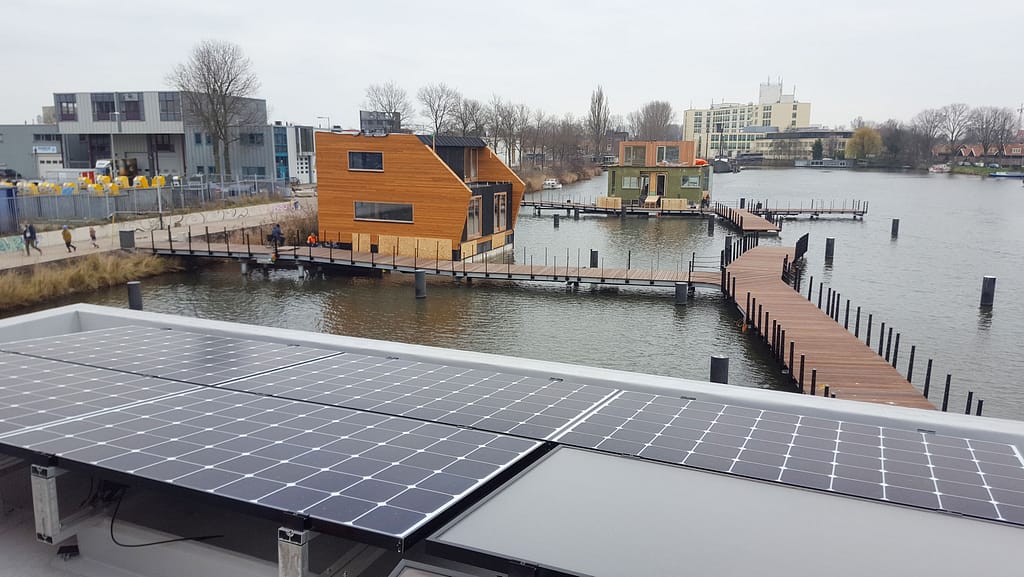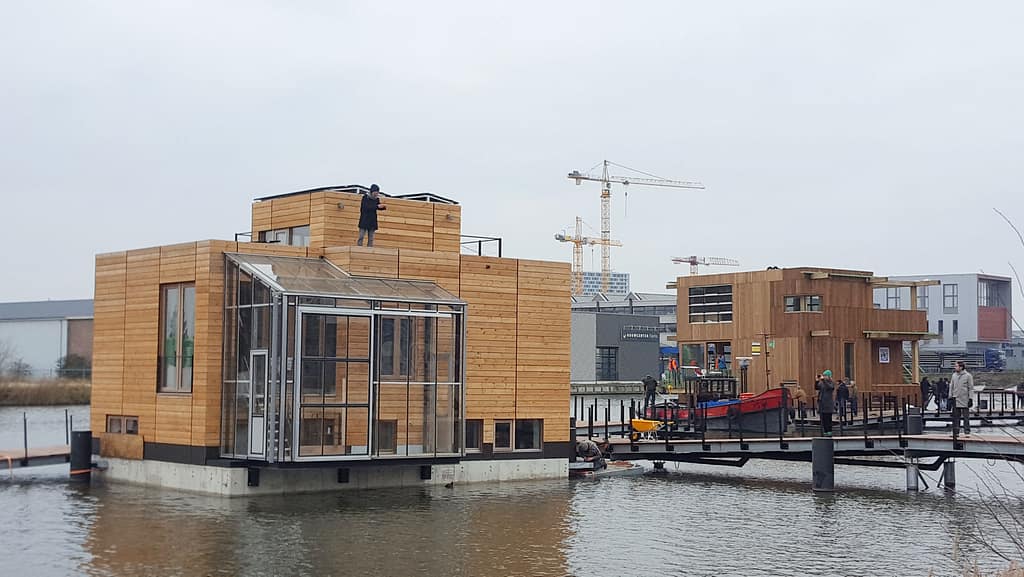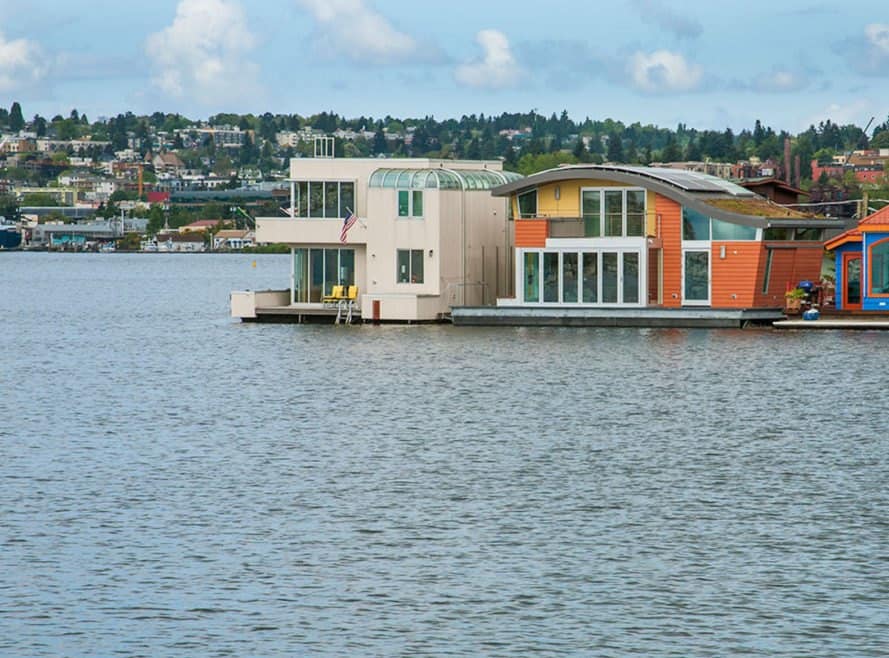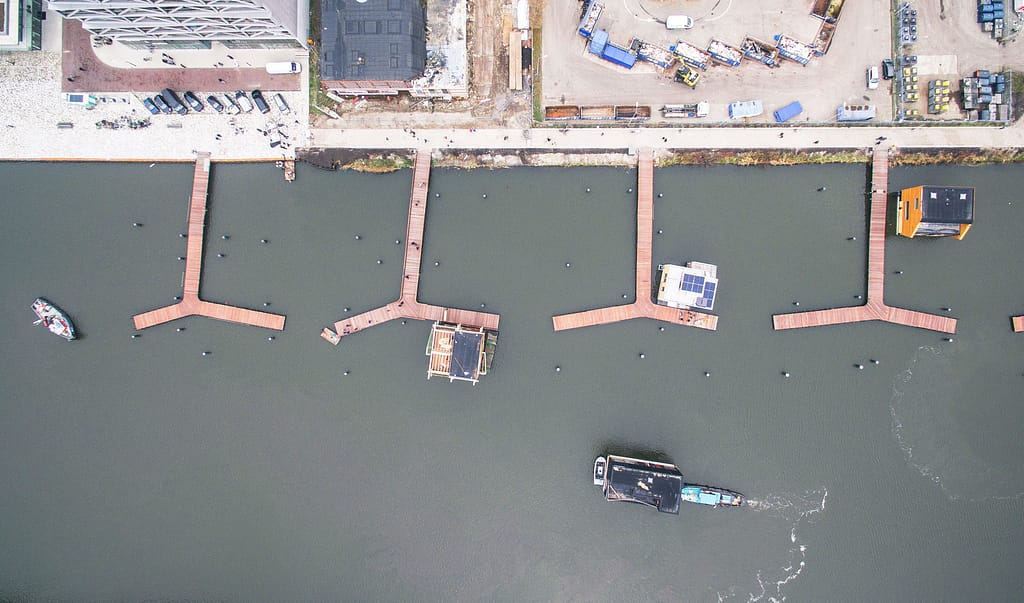It is one of the defining questions of our age: do we focus on reducing the impacts of climate change, or switch our efforts to adapting to it? The Schoonschip floating community in Amsterdam has a simple answer: why not do both at the same time?
In a world of rising sea levels, the Schoonschip floating community (Dutch for “clean ship”) is showing how to live sustainably on the water. Over the past few years, houseboats were towed down the Johan van Hasselt canal in North Amsterdam and moored in place near the De Ceuvel cleantech playground. Today the neighborhood is housing over 100 residents across 46 households, all experimenting with sustainable solutions to the unique challenges of on-water living.
Schoonschip is an example of growing relevance to urban planners working in coastal areas – if action to reduce carbon emissions doesn’t ramp up significantly, the C40 network estimates 800 million people will be put at risk from sea level rise of at least half a meter by the 2050s. Global average sea level has already risen by about 16–21 cm since 1900, with about 7 cm occurring since 1993. Similar floating communities with sustainability at their core are found around the world, from Rotterdam, in the Netherlands, to Seattle, Washington, in the United States.

Water is something to live with and enjoy
Marjolein Smeele, a Schoonschip Foundation board member, resident, and one of the architects behind the community, says she thinks the neighborhood can be “an example of how to live on the water” in a country where nearly 30% of the land lies below sea level. “Being Dutch, we are used to living under the level of the sea,” she says. “It would be normal to feel scared about water because we are so low, but we don’t because we’ve arranged things so well. Water for us is something to live with and enjoy, not to be afraid of – we Dutch have built great things to protect us from our water.”
The Netherlands’ formidable network of sea barriers is the most obvious example of this, but the Schoonschip floating community shows another way of coping with rising oceans – by floating on them. The key is to build a sustainable neighborhood suited to the challenges of an aquatic environment and that harnesses the unique synergies it offers to residents. To achieve this goal, a range of approaches are being tried. “Solar panels, good insulation, water recycling showers, vacuum toilets – each boat is different,” Smeele says. “Some people decided to look for good materials for clean building, others wanted everything green, so have green on their facades and roof. Everyone took something they really wanted to go for.”

Innovators float sustainable solutions
This is where Metabolic came in during the early phases of development, working with municipal authorities and a coalition of innovators including architects Space&Matter to draft a sustainability masterplan for a floating development that prioritizes sustainability. Instead of relying on carbon-intensive gas heating, homes are well-insulated and utilize passive solar heating through designs that make the most of natural sunlight, complemented by pumps that harvest warmth from the canal water, even in winter. Solar boilers provide hot water, and water-recycling showers are equipped with technologies that recover heat that would otherwise go down the drain.
In terms of building materials, the priority is materials that are sustainable, lightweight, and buoyant – bamboo is one favored option, as is hemplime created as a by-product of the cultivation of hemp seeds and fibers. A community center serves as a hub for neighborhood-wide sustainability initiatives, the kind of which community members have been engaged in long before moving in – for instance a 2017 boat tour to fish out plastic from the canal.
Schoonschip community floating into place
The houses were constructed off-site and towed in groups to the location, an approach Space&Matter co-founder Sascha Glasl has suggested could be used to respond to flooding disasters. “If you have a catastrophe somewhere and you have these houses in stock, from one day to the other, a neighborhood can appear,” he says. Glasl added that a hybrid model could be developed for “amphibious” homes on dry land that can float during times of flood. “When the water comes, they float,” he says. “When the water goes away, then they can stand again.”

Smart microgrid on the water
One of the most innovative aspects of the project is a smart grid devised by Metabolic spinoff Spectral, which is working closely with research partners Fraunhofer ITWM and CWI as part of the EU commission-backed Grid-Friends project. The Schoonschip floating community holds a special permit that gives them ownership of their own grid and full responsibility for energy sourcing and billing. Each household is equipped with a large solar PV array and heat pump, with energy stored in battery storage systems – each positioned close to the center of its respective boat so as not to cause the vessel to keel. The households are connected to an energy management system which intelligently coordinates supply and demand within the community microgrid, and allows residents to trade energy with each other.
Spectral founder and CEO, Philip Gladek, says the project team is coordinating with partners including green energy supplier Greenchoice to enable the Schoonschip microgrid to provide support to the broader energy market, providing frequency regulation and other services to the Dutch transmission system operator Tennet. “As we shut down the baseline generation from coal power plants and entirely move away from fossil fuels, communities like Schoonschip will play an essential role in balancing the public electricity grid to ensure we can keep the lights on,” he says.

Other floating neighborhoods in the Netherlands and around the world
The fascination of living on the water is not exclusive to the Netherlands. Around the world, we are seeing more floating communities similar to Schoonship being built. This trend is expected to increase as a way to mitigate and adapt to the effects of the climate crisis.
The Nassau Harbor, Rotterdam
The city of Rotterdam shares the ambition to explore opportunities presented by building floating developments. In 2020, Rotterdam started building its first small-scale floating residential neighborhood in the Nassau harbor.

While the 18 planned lofts here are not yet ready for residents, Nassau harbor is being transformed into a sustainable floating community. Just like Schoonschip, one of the main goals of this new neighborhood is to be as sustainable as possible.
To avoid excessive disruption to the ecosystem on the banks of the harbor, the municipality created a nature-friendly bank. Maintaining room for animals and plants, the bank borders the existing Nassauhaven Park and has been designed as steps to promote plant growth and biodiversity. Furthermore, the buildings are made with an inert material that does not release pollutants into the rainwater. The harbor lofts are also fitted with solar panels, can generate heat using a biomass installation, and are equipped with their own water purification system.
Refshaleøen Island, Copenhagen
In 2017, Bjarke Ingels’ practice BIG transformed a former industrial dock area into a sustainable floating student housing project, Urban Rigger, luring students to try out a new way of living on the water.

Created with sustainable goals in mind, the Urban Rigger studios are made from end-of-life shipping containers. Solar panels provide part of the electricity, and a hydro-sourced heating technology uses the harbor water for heating purposes. These features substantially lower the studios’ carbon footprint, which has reduced emissions by 81% in comparison to conventional housing. There are plans to expand the concept to Sweden and beyond.
Lake Union, Seattle
In the United States, Seattle’s Lake Union has hosted a floating neighborhood since the 1920s, and today there are more than 500 homes. One of the latest additions is Houseboat H, which was created by a team of designers to be in a symbiotic relationship with the lake.

A showcase of sustainability, this floating house was built from recycled materials and with sustainable characteristics including maximum insulation, minimum air leakage, rapidly renewable materials, and more. Houseboat H has been designed with technology that improves water quality and creates new habitats for aquatic life. For instance, the house’s planters allow the roots of native plants to eventually grow into the water below, creating fish habitats.
Replicable blueprint for green building
For Metabolic, sharing what has been learned about the Amsterdam floating community is an important part of the project.
“One of the greatest things about Schoonschip is it has resulted in a largely replicable blueprint for the cutting edge of green building and how you can implement that into homes, and that is going to be made public,” says Eva Gladek, Metabolic CEO and founder. “I’m very happy the community has decided to share the knowledge we developed in this process.”
Having done the hard work of trialing new technologies and approaches – and the regulatory challenges involved – the team behind the Schoonschip floating community hopes that lessons can be learned which could be applied to building projects globally, both on land and on water. After all – a rising tide lifts all boats.
For more details on the Schoonschip project, visit their website, and our summary of the floating community. To find out more about smart microgrids, contact Spectral. For more on sustainable neighborhoods, reach out to our green building consultant Nico Schouten.





